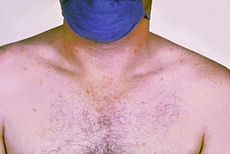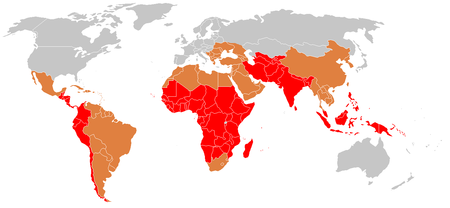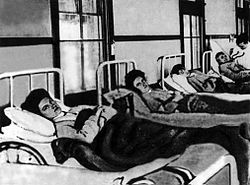
Typhoid fever
Did you know...
This Wikipedia selection is available offline from SOS Children for distribution in the developing world. SOS Children works in 45 African countries; can you help a child in Africa?
Typhoid fever, also known simply as typhoid, is a common worldwide bacterial disease, transmitted by the ingestion of food or water contaminated with the feces of an infected person, which contain the bacterium Salmonella typhi, serotype Typhi.
The disease has received various names, such as gastric fever, abdominal typhus, infantile remittant fever, slow fever, nervous fever or pythogenic fever. The name "typhoid" means "resembling typhus" and comes from the neuropsychiatric symptoms common to typhoid and typhus. Despite this similarity of their names, typhoid fever and typhus are distinct diseases and are caused by different species of bacteria.
The impact of this disease fell sharply in the developed world with the application of 20th century sanitation techniques.
Signs and symptoms
Classically, the course of untreated typhoid fever is divided into four individual stages, each lasting approximately one week. In the first week, the temperature rises slowly and fever fluctuations are seen with relative bradycardia, malaise, headache, and cough. A bloody nose ( epistaxis) is seen in a quarter of cases and abdominal pain is also possible. There is a decrease in the number of circulating white blood cells ( leukopenia) with eosinopenia and relative lymphocytosis, a positive reaction and blood cultures are positive for Salmonella typhi or paratyphi. The Widal test is negative in the first week.
In the second week of the infection, the patient lies prostrate with high fever in plateau around 40 °C (104 °F) and bradycardia (sphygmothermic dissociation or Faget sign), classically with a dicrotic pulse wave. Delirium is frequent, frequently calm, but sometimes agitated. This delirium gives to typhoid the nickname of "nervous fever". Rose spots appear on the lower chest and abdomen in around a third of patients. There are rhonchi in lung bases.
The abdomen is distended and painful in the right lower quadrant where borborygmi can be heard. Diarrhea can occur in this stage: six to eight stools in a day, green, comparable to pea soup, with a characteristic smell. However, constipation is also frequent. The spleen and liver are enlarged ( hepatosplenomegaly) and tender, and there is elevation of liver transaminases. The Widal test is strongly positive with antiO and antiH antibodies. Blood cultures are sometimes still positive at this stage. (The major symptom of this fever is that the fever usually rises in the afternoon up to the first and second week.)
In the third week of typhoid fever, a number of complications can occur:
- Intestinal hemorrhage due to bleeding in congested Peyer's patches; this can be very serious but is usually not fatal.
- Intestinal perforation in the distal ileum: this is a very serious complication and is frequently fatal. It may occur without alarming symptoms until septicaemia or diffuse peritonitis sets in.
- Encephalitis
- Neuropsychiatric symptoms (described as "muttering delirium" or "coma vigil"), with picking at bedclothes or imaginary objects.
- Metastatic abscesses, cholecystitis, endocarditis and osteitis
The fever is still very high and oscillates very little over 24 hours. Dehydration ensues and the patient is delirious (typhoid state). By the end of third week the fever starts subsiding ( defervescence). This carries on into the fourth and final week.
Transmission
The bacterium which causes typhoid fever may be spread through poor hygiene habits and public sanitation conditions, and sometimes also by flying insects feeding on feces. Public education campaigns encouraging people to wash their hands after defecating and before handling food are an important component in controlling spread of the disease. According to statistics from the United States Centers for Disease Control and Prevention (CDC), the chlorination of drinking water has led to dramatic decreases in the transmission of typhoid fever in the U.S.A.
A person may become an asymptomatic carrier of typhoid fever, suffering no symptoms, but capable of infecting others. According to the CDC approximately 5% of people who contract typhoid continue to carry the disease after they recover. The most famous asymptomatic carrier was Mary Mallon (commonly known as " Typhoid Mary"), a young cook who was responsible for infecting at least 53 people with typhoid, three of whom died from the disease. Mallon was the first apparently perfectly healthy person known to be responsible for a Typhoid "epidemic".
In the early 20th century, many carriers of typhoid were locked into an isolation ward never to be released to prevent further typhoid cases. These people often deteriorated mentally, driven mad by the conditions they lived in.
Possible protective effects of heterozygosity for cystic fibrosis
It has been hypothesized that cystic fibrosis may have risen to its present levels (1 in 2,500 in UK) due to the heterozygous advantage that it confers against typhoid fever. The CFTR protein is present in both the lungs and the intestinal epithelium, and the mutant cystic fibrosis form of the CFTR protein prevents entry of the typhoid bacterium into the body through the intestinal epithelium. However, the heterozygous advantage hypothesis was proposed in one review in which the author himself writes, "Although cellular/molecular evidence presently is not available for this hypothesis, the CF mutation may be one of several mutations that have spread in European populations because they increased resistance to infectious diseases." Since no molecular experimental evidence has been presented in support of this theory, this theory is not accepted by the majority of the scientific community.
Diagnosis
Diagnosis is made by any blood, bone marrow or stool cultures and with the Widal test (demonstration of salmonella antibodies against antigens O-somatic and H-flagellar). In epidemics and less wealthy countries, after excluding malaria, dysentery or pneumonia, a therapeutic trial time with chloramphenicol is generally undertaken while awaiting the results of Widal test and cultures of the blood and stool.
The Widal test is time consuming and often, when a diagnosis is reached, it is too late to start an antibiotic regimen.
The term "enteric fever" is a collective term that refers to typhoid and paratyphoid.
Prevention
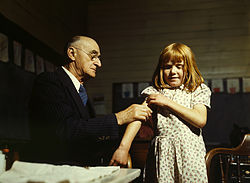
Sanitation and hygiene are the critical measures that can be taken to prevent typhoid. Typhoid does not affect animals and therefore transmission is only from human to human. Typhoid can only spread in environments where human feces or urine are able to come into contact with food or drinking water. Careful food preparation and washing of hands are crucial to prevent typhoid.
There are two vaccines licensed for use for the prevention of typhoid: the live, oral Ty21a vaccine (sold as Vivotif Berna) and the injectable Typhoid polysaccharide vaccine (sold as Typhim Vi by Sanofi Pasteur and Typherix by GlaxoSmithKline). Both are between 50% to 80% protective and are recommended for travellers to areas where typhoid is endemic. Boosters are recommended every five years for the oral vaccine and every two years for the injectable form. There exists an older killed whole-cell vaccine that is still used in countries where the newer preparations are not available, but this vaccine is no longer recommended for use, because it has a higher rate of side effects (mainly pain and inflammation at the site of the injection).
Medical treatment
The rediscovery of oral rehydration therapy in the 1960s provided a simple way to prevent many of the deaths of diarrheal diseases in general.
Where resistance is uncommon, the treatment of choice is a fluoroquinolone such as ciprofloxacin. Otherwise, a third-generation cephalosporin such as ceftriaxone or cefotaxime is the first choice. Cefixime is a suitable oral alternative.
Typhoid fever in most cases is not fatal. Antibiotics, such as ampicillin, chloramphenicol, trimethoprim-sulfamethoxazole, amoxicillin and ciprofloxacin, have been commonly used to treat typhoid fever in microbiology. (Baron S et al.) Treatment of the disease with antibiotics reduces the case-fatality rate to approximately 1%.
When untreated, typhoid fever persists for three weeks to a month. Death occurs in between 10% and 30% of untreated cases. In some communities, however, case-fatality rates may reach as high as 47%.
Surgical treatment
Surgery is usually indicated in cases of intestinal perforation. Most surgeons prefer simple closure of the perforation with drainage of the peritoneum. Small-bowel resection is indicated for patients with multiple perforations.
If antibiotic treatment fails to eradicate the hepatobiliary carriage, the gallbladder should be resected. Cholecystectomy is not always successful in eradicating the carrier state because of persisting hepatic infection.
Resistance
Resistance to ampicillin, chloramphenicol, trimethoprim-sulfamethoxazole, and streptomycin is now common, and these agents have not been used as first–line treatment now for almost 20 years. Typhoid that is resistant to these agents is known as multidrug-resistant typhoid (MDR typhoid).
Ciprofloxacin resistance is an increasing problem, especially in the Indian subcontinent and Southeast Asia. Many centres are therefore moving away from using ciprofloxacin as the first line for treating suspected typhoid originating in South America, India, Pakistan, Bangladesh, Thailand, or Vietnam. For these patients, the recommended first line treatment is ceftriaxone. It has also been suggested that azithromycin is better at treating typhoid in resistant populations than both fluoroquinolone drugs and ceftriaxone. Azithromycin significantly reduces relapse rates compared with ceftriaxone.
There is a separate problem with laboratory testing for reduced susceptibility to ciprofloxacin: current recommendations are that isolates should be tested simultaneously against ciprofloxacin (CIP) and against nalidixic acid (NAL), and that isolates that are sensitive to both CIP and NAL should be reported as "sensitive to ciprofloxacin", but that isolates testing sensitive to CIP but not to NAL should be reported as "reduced sensitivity to ciprofloxacin". However, an analysis of 271 isolates showed that around 18% of isolates with a reduced susceptibility to ciprofloxacin ( MIC 0.125–1.0 mg/l) would not be picked up by this method. It is not certain how this problem can be solved, because most laboratories around the world (including the West) are dependent on disk testing and cannot test for MICs.
Epidemiology
With an estimated 16–33 million cases of typhoid fever annually resulting in 216,000 deaths in endemic areas, the World Health Organization identifies typhoid as a serious public health problem. Its incidence is highest in children and young adults between 5 and 19 years old.
History
Around 430–424 BC, a devastating plague, which some believe to have been typhoid fever, killed one third of the population of Athens, including their leader Pericles. The balance of power shifted from Athens to Sparta, ending the Golden Age of Pericles that had marked Athenian dominance in the Greek ancient world. Ancient historian Thucydides also contracted the disease, but he survived to write about the plague. His writings are the primary source on this outbreak and modern academics and medical scientists consider epidemic typhus the most likely cause. However, 2006 study detected DNA sequences similar to those of the bacterium responsible for typhoid fever.
The cause of the plague has long been disputed and other scientists have disputed the findings, citing serious methodologic flaws in the dental pulp-derived DNA study. The disease is most commonly transmitted through poor hygiene habits and public sanitation conditions; during the period in question, the whole population of Attica was besieged within the Long Walls and lived in tents.
Some historians believe that the English colony of Jamestown, Virginia, died out from typhoid. Typhoid fever killed more than 6000 settlers between 1607 and 1624. During the American Civil War, 81,360 Union soldiers died of typhoid or dysentery. In the late 19th century, the typhoid fever mortality rate in Chicago averaged 65 per 100,000 people a year. The worst year was 1891, when the typhoid death rate was 174 per 100,000 people.
The most notorious carrier of typhoid fever—but by no means the most destructive—was Mary Mallon, also known as Typhoid Mary. In 1907, she became the first American carrier to be identified and traced. She was a cook in New York. She is closely associated with fifty-three cases and three deaths. Public health authorities told Mary to give up working as a cook or have her gall bladder removed. Mary quit her job but returned later under a false name. She was detained and quarantined after another typhoid outbreak. She died of pneumonia after 26 years in quarantine.
In 1880 Karl Joseph Eberth described a bacillus that he suspected was the cause of typhoid. In 1884 pathologist Georg Theodor August Gaffky (1850–1918) confirmed Eberth's findings, and the organism was given names such as Eberth's bacillus, Eberthella typhi and Gaffky-Eberth bacillus. Today the bacillus that causes typhoid fever goes by the scientific name of Salmonella enterica enterica, serovar Typhi.
Almroth Edward Wright developed an effective inactivated whole-cell typhoid vaccine that was introduced in 1896. In 1909, Frederick F. Russell, a U.S. Army physician, developed an American typhoid vaccine and two years later his vaccination program became the first in which an entire army was immunized. It eliminated typhoid as a significant cause of morbidity and mortality in the U.S. military.
Most developed countries saw declining rates of typhoid fever throughout the first half of the 20th century due to vaccinations and advances in public sanitation and hygiene. In 1908, the chlorination of drinking water was a significant step in the control of typhoid fever in the U.S. The first permanent disinfection of drinking water in the U.S. occurred on the Jersey City, New Jersey water supply. Credit for the decision to build the chlorination system has been given to John L. Leal The chlorination facility was designed by George W. Fuller. Antibiotics were introduced in clinical practice in 1942, greatly reducing mortality. Today, the incidence of typhoid fever in developed countries is around 5 cases per 1,000,000 people per year.
A notable outbreak occurred in Aberdeen, Scotland in 1964. This was due to contaminated tinned meat sold at the city's branch of the William Low chain of stores. No fatalies resulted.
An outbreak in the Democratic Republic of Congo in 2004–05 recorded more than 42,000 cases and 214 deaths.
Typhoid fever was also known as suette milliaire in nineteenth-century France.
Famous victims
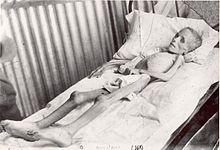
Famous people who have had the disease include
- Franz Schubert died 19 November 1828 officially of typhoid but other theories also exist.
- Baiju Bawra aka (Baijnath Prasad or Baijnath Mishra), an Indian singer and musician died of typhoid at the age of 71 on the eve of the Indian festival, Basant Panchami in Vikram Samvat 1670 (1613 CE).
- Hakaru Hashimoto, discoverer of Autoimmune Thyroiditis Hashimoto's thyroiditis. Died on January 9, 1934, of typhoid fever.
- Andrew Johnson, seventeenth President of the United States, suffered of typhoid fever months before he was inaugurated as the sixteenth vice-president.
- Mary Mallon, more commonly known as Typhoid Mary, survived a childhood episode in Ireland to become an asymptomatic carrier in the United States.
- Abigail Adams, second First Lady of the United States, wife of John Adams, died of typhoid fever on October 28, 1818.
- Prince Albert of Saxe-Coburg-Gotha, British prince consort, Queen Victoria's husband, died of typhoid fever on 14 December 1861.
- Edward VII survived in December 1871.
- Joseph Smith, Jr., founder of the Church of Jesus Christ of Latter-day Saints Latter Day Saint movement, contracted typhoid as a child, survived.
- Henry Frederick, Prince of Wales
- Princess Victoria of Hesse and by Rhine survived.
- Princess Leopoldina of Brazil, Emperor Pedro II of Brazil's daughter, died of typhoid Fever on 7 February 1871.
- Tadeusz Kosciuszko, hero of the American Revolution and Polish patriot leader, died of typhoid Fever in Switzerland, 1817.
- Louisa May Alcott, author of Little Women, records contracting it in Hospital Sketches.
- Ignacio Zaragoza, Mexican general and Cinco de Mayo hero. Died of typhoid fever on September 8, 1862, about four months after his famous victory over the French army in Puebla.
- Urilla Sutherland Earp, first wife of Marshall Wyatt Earp, probably died of Typhoid Fever in or around 1870 in Lamar Township, Missouri.
- Eugenia Tadolini, a celebrated Italian soprano, died of the disease in Paris in 1872.
- Leland Stanford, Jr. died of typhoid in 1884; his parents founded Stanford University in his memory.
- William Wallace Lincoln, third son of Abraham Lincoln, the 16th President of the United States, died February 20, 1862 of typhoid fever.
- Mary Todd Lincoln, wife of Abraham Lincoln.
- George Washington Gale Ferris, Jr., the inventor of the Ferris Wheel, died in 1896
- Thoby Stephen, elder brother of novelist Virginia Woolf, died of typhoid fever in 1906 at age 26. The deaths of Woolf's characters, Jacob in Jacob's Room and Percival in The Waves, are based on Thoby's.
- Wilbur Wright, one of the famous Wright Brothers. Died May 30, 1912 of typhoid fever. His brother Orville had contracted the disease in 1896 but survived.
- Frank McCourt, author of Angela's Ashes. In his memoir, he details nearly dying of the disease in 1940 as a ten-year-old in Limerick, Ireland, and his ensuing 4-month-long hospital stay.
- Stephen Douglas, politician and 1860 presidential runner-up.
- Dr HJH 'Tup' Scott, captain of the 1886 Australian cricket team that toured England, died of typhoid in 1910.
- Arnold Bennett, English novelist, died in 1932 of typhoid, two months after drinking a glass of water in a Paris hotel to prove it was safe.
- Raymond Radiguet, French literary prodigy, died of typhoid at age 20 while on a trip with his mentor, Jean Cocteau.
- Keshav Baliram Hedgewar, founder and first Sarsanghchalak of Rashtriya Swayamsevak Sangh, died of typhoid at age 51 on June 21, 1940.
- Gerard Manley Hopkins, Jesuit and poet.
- Ralph Rose, three-time Olympic champion and six-time medalist in throwing events, died of typhoid on October 16, 1913 at age 28.
- Roger Sherman, a Founding Father of the United States of America.
- Georgia O'Keeffe, a famous painter, survived
- Ravi Shankar, musician, survived
- Tsar Nicholas II of Russia had typhoid in 1900, survived.
- Heath Bell, Relief Pitcher San Diego Padres acquired on 2010 trip to Fiji, survived.
- Mark Hanna - Died, 1904. Republican Party boss and United States Senator representing Ohio. Contracted Tyhpoid from drinking tainted tap water in Columbus, Ohio. Hanna's death prompted Columbus city officials modernize the public water system and how it handled raw sewage.
- Henry Ernest Wild, a member of Ernest Shackleton's Trans-Antarctic Ross Sea Party. After surviving and eventually being rescued, in 1917 Wild returned to naval duty on HMS Pembroke, later transferring to HMS Biarritz. He died on 10 March 1918[11] in the Royal Naval Hospital, Malta, after contracting typhoid. He is buried in the Naval Cemetery in Kalkara, Malta.
In fiction
- Gilbert Blythe (of the Anne of Green Gables series) almost dies of typhoid fever in Anne of the Island by L.M. Montgomery.
- Walter Blythe (son of Anne and Gilbert Blythe in the latter Anne of Green Gables books) was in recovery from typhoid in "Rilla of Ingleside" and this is seen as the reason why he does not enlist at the onset of WWI.
- Johann "Hanno" Buddenbrook, in Thomas Mann's novel, Buddenbrooks, dies of typhoid fever, and the book includes a long medical description of the disease and its effects.
- John H. Watson (Sherlock Holmes' famed companion) nearly died of typhoid contracted in India, and returned to England for convalescence – where he first met the detective.
- Scarlett O'Hara's mother Ellen in Gone With the Wind. Scarlett's sisters Suellen and Carreen also contract the disease, but survive.
- Suttree in the Cormac McCarthy novel of the same name nearly dies of typhoid fever in the final scenes of the novel.
- In the 1950 western Stars in My Crown, the town is devastated by typhoid spread by a school's well.
- Port Moresby in Paul Bowles' The Sheltering Sky, in North Africa.
- Tom's friend Arthur suffers from a near fatal bout with typhoid but ultimately recovers in Thomas Hughes' novel Tom Brown's Schooldays.
- Fred Vincy in George Eliot's Middlemarch is treated for typhoid fever by Dr. Lydgate, who falls in love with and marries Fred's sister Rosamond.
- Raskolnikov's fiancée Natalya Yegorovna Zarnitsyna in Dostoevsky's Crime and Punishment died from it three years before the novel takes place.
- Joey, one of the few remaining human survivors who can read, dies of typhoid fever in George Stewart's Earth Abides.
- Yevgeny Vassilievitch Bazarov, the nihilist in Ivan Turgenev's Fathers and Sons, dies of typhoid fever contracted through a cut in his finger near an infected corpse.
- Samya's daughter Mia in Andrée Chedid's From Sleep Unbound (Le Sommeil délivré) dies of typhoid fever at age six.

